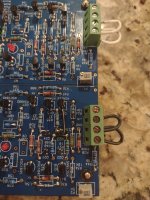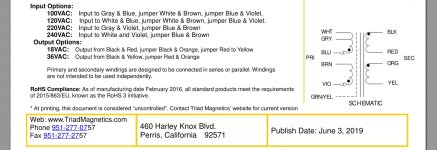I would argue that the sheer talent of and wonderfulnezzez of MZM, would require either a mom and dad with extreme abilities, and that a fair share of the best of those genes were passed on to the mighty one. This might be an unlikely circumstance, and begs the question: is MZM MZM’s mom?

Dear, MZM. With all due respect, not all DIY’ers have nail polish readily available in the workshop
In all seriousness, clear nail polish is very useful for the bench… for example you can varnish PCB as ZM says, use it as thread lock, and secure slightly loose tube bases back to the glass.
I keep four bottles of nail polish on the bench. Clear, red, green, black. Purchased from the cheapest-of-the-cheap lines of cosmetics, aimed at 13 year old customers.
It's a handy threadlocker and it's great for fixing the knob of a 25 turn trimmer potentiometer after you spend 15 painstaking minutes getting the adjustment exactly right. Also good for marking matched pairs of transistors: left channel pair gets a 1mm dot of green nail polish on each device, right channel pair gets a dot of red nail polish on each device.
Also good for making diodes (even LEDs) completely opaque. Paint with two coats of black polish. Now you don't have to worry about emission or incoming impingement of light.
It's a handy threadlocker and it's great for fixing the knob of a 25 turn trimmer potentiometer after you spend 15 painstaking minutes getting the adjustment exactly right. Also good for marking matched pairs of transistors: left channel pair gets a 1mm dot of green nail polish on each device, right channel pair gets a dot of red nail polish on each device.
Also good for making diodes (even LEDs) completely opaque. Paint with two coats of black polish. Now you don't have to worry about emission or incoming impingement of light.
That's interesting. Just curious...Now you don't have to worry about emission or incoming impingement of light.
Are diodes like the 1N4148 sensitive (and susceptible) to the vagaries of light? Would a coat of black be remiss?
Without an opaque case do other diodes emit light?
That's interesting. Just curious...
Are diodes like the 1N4148 sensitive (and susceptible) to the vagaries of light? Would a coat of black be remiss?
Without an opaque case do other diodes emit light?
See posts #211 - #215 in (this thread) for another member's anecdotes
@Mark Johnson
Very interesting. Thanks.
I guess "goth" had its uses... but I don't see many of those in the seniors village.
Very interesting. Thanks.
I guess "goth" had its uses... but I don't see many of those in the seniors village.
Warning....graphic PCB carnage. I thought what the heck, nothing to lose at this point. Soldered two pieces of a resistor leg cutoff from the sk209 to the one proper points on the circuit. And guess what the darn thing got down to 10 mv of DC offset. No idea if it makes sound but that's next. Thanks for the encouragement 🙏. Still gonna build another board up.
Attachments
Soldered two pieces of a resistor leg
darn
thin wire, not Palamar - you're lucky if you didn't cook tiny SMD that way
you certainly have some stranded wire around, take one tiny strand next time
I have a bunch of pairs Toshiba 2SK170, they are Blue and with measured IDss of 9 to 11.1. Any ideas on whether it would be beneficial to substitute them for the 2SK209?
May need to employ different art form of sorcery as 2SK170 is TO-92 while 2SK209 is SMD😎
...your mileage may vary.
...your mileage may vary.
What sorcerey is this? It actually makes music first try.
LOL. Kudos to you for keeping your build simple and effective. Enjoy!
Can someone please let me know if I’m interpreting this incorrectly?
I have this transformer https://www.digikey.com.au/en/htmldatasheets/production/1837742/0/0/1/vpm36-1390-datasheet connected to a Glassware dual/bipolar LV reg. I’ve had it hooked up with the BA2018 and "working" for months but I was getting intermittent crackling through the speakers.
Because of this and several other reasons (I have adhd, that’s all the other reasons) I’m in the process of rebuilding my preamp and while reconnecting the power I realised to my great amazement and delight that I had twinned the wrong two secondaries from the transformer into the PSU board, which was obviously what was causing the crackling, which I decided based on my vast electronics experience consisting of a lifetime of pressing the buttons on things. Now, I don’t know, because when I hooked it up this time it i can’t get it working at all.
In trying to work out what the destructive change was I’ve pulled everything back to the (fused) ac input, the transformer, the PSU and the BA2018 board. It still sounds like **** and one or two of the diodes on one side of the glassware are getting into the 60s/70sC while the rest are around 27C so I’ve either hosed half my linestage board (I cut it in half) or… something.
The attached images are how I have the unit hooked up currently and the relevant bit of the transformer data sheet. Am I doing it wrong now or was I doing it wrong before? Thanks
I have this transformer https://www.digikey.com.au/en/htmldatasheets/production/1837742/0/0/1/vpm36-1390-datasheet connected to a Glassware dual/bipolar LV reg. I’ve had it hooked up with the BA2018 and "working" for months but I was getting intermittent crackling through the speakers.
Because of this and several other reasons (I have adhd, that’s all the other reasons) I’m in the process of rebuilding my preamp and while reconnecting the power I realised to my great amazement and delight that I had twinned the wrong two secondaries from the transformer into the PSU board, which was obviously what was causing the crackling, which I decided based on my vast electronics experience consisting of a lifetime of pressing the buttons on things. Now, I don’t know, because when I hooked it up this time it i can’t get it working at all.
In trying to work out what the destructive change was I’ve pulled everything back to the (fused) ac input, the transformer, the PSU and the BA2018 board. It still sounds like **** and one or two of the diodes on one side of the glassware are getting into the 60s/70sC while the rest are around 27C so I’ve either hosed half my linestage board (I cut it in half) or… something.
The attached images are how I have the unit hooked up currently and the relevant bit of the transformer data sheet. Am I doing it wrong now or was I doing it wrong before? Thanks
Attachments
- Home
- Amplifiers
- Pass Labs
- Wayne's BA 2018 linestage






